HNN215 Quality Use of Medicines: Case Study of Ms. Tong's Medications
VerifiedAdded on 2022/10/04
|9
|2547
|28
Report
AI Summary
This nursing assignment analyzes the case of Ms. Candice Tong, a 56-year-old patient admitted to Deakin Hospital with peptic ulcers. The report examines the potential side effects of her prescribed medications, including Metroclopramide, Clarithromycin, and anti-hypertensive drugs, considering her history of hypertension and depression. It identifies risks such as decreased blood pressure, stomach pain, and neuropsychiatric complications. The assignment emphasizes the importance of nursing interventions, such as blood pressure monitoring, pain management strategies (music therapy), and mindfulness-based therapy to address depression and anxiety. It also discusses the risks associated with Ibuprofen and St. John's Wort, highlighting the need for patient education regarding over-the-counter (OTC) medications, including potential liver damage and the use of FDA checklists. The report stresses the role of pharmacists in managing OTC medication side effects and the importance of monitoring Ms. Tong's vital signs to prevent complications.
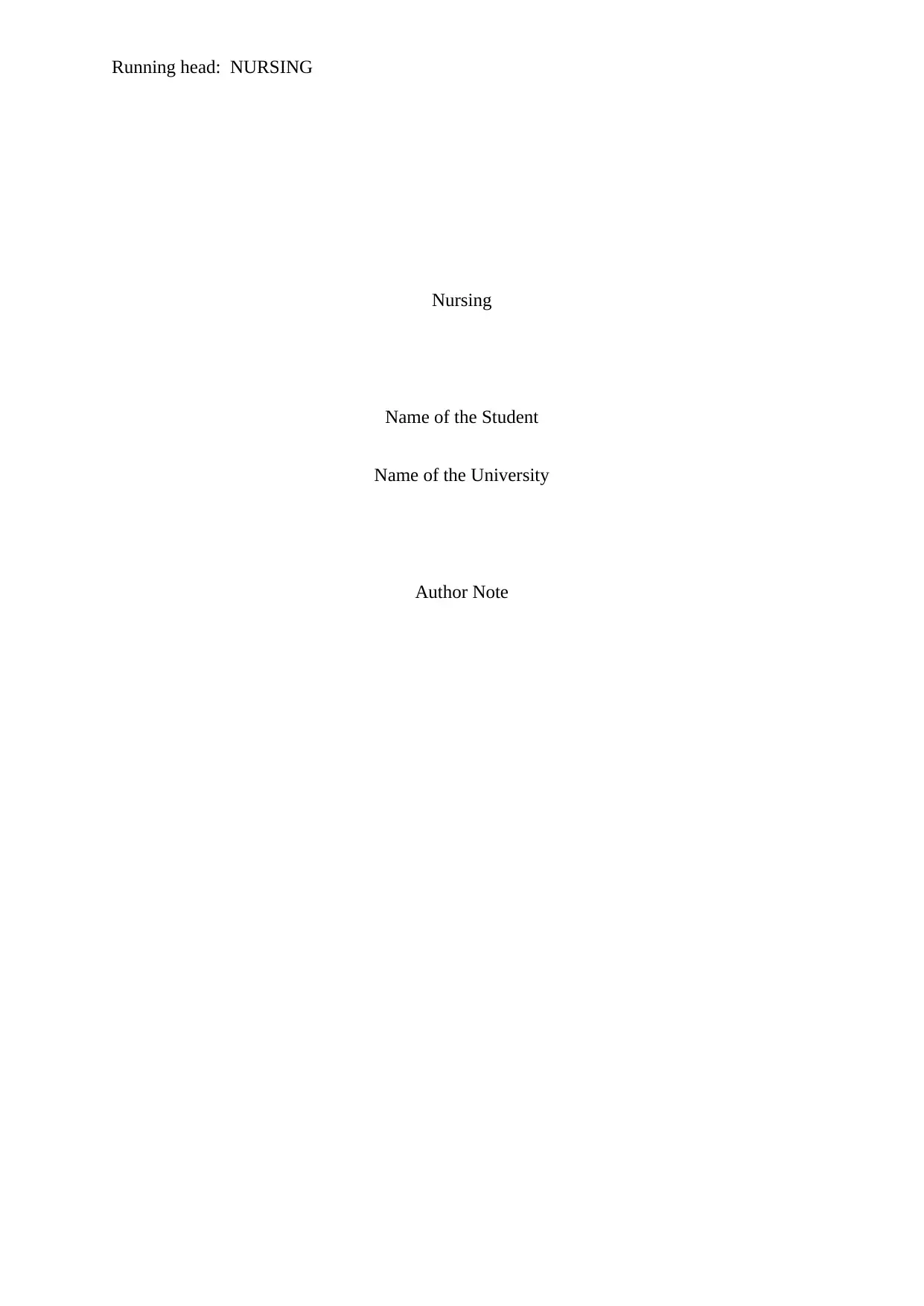
Running head: NURSING
Nursing
Name of the Student
Name of the University
Author Note
Nursing
Name of the Student
Name of the University
Author Note
Paraphrase This Document
Need a fresh take? Get an instant paraphrase of this document with our AI Paraphraser
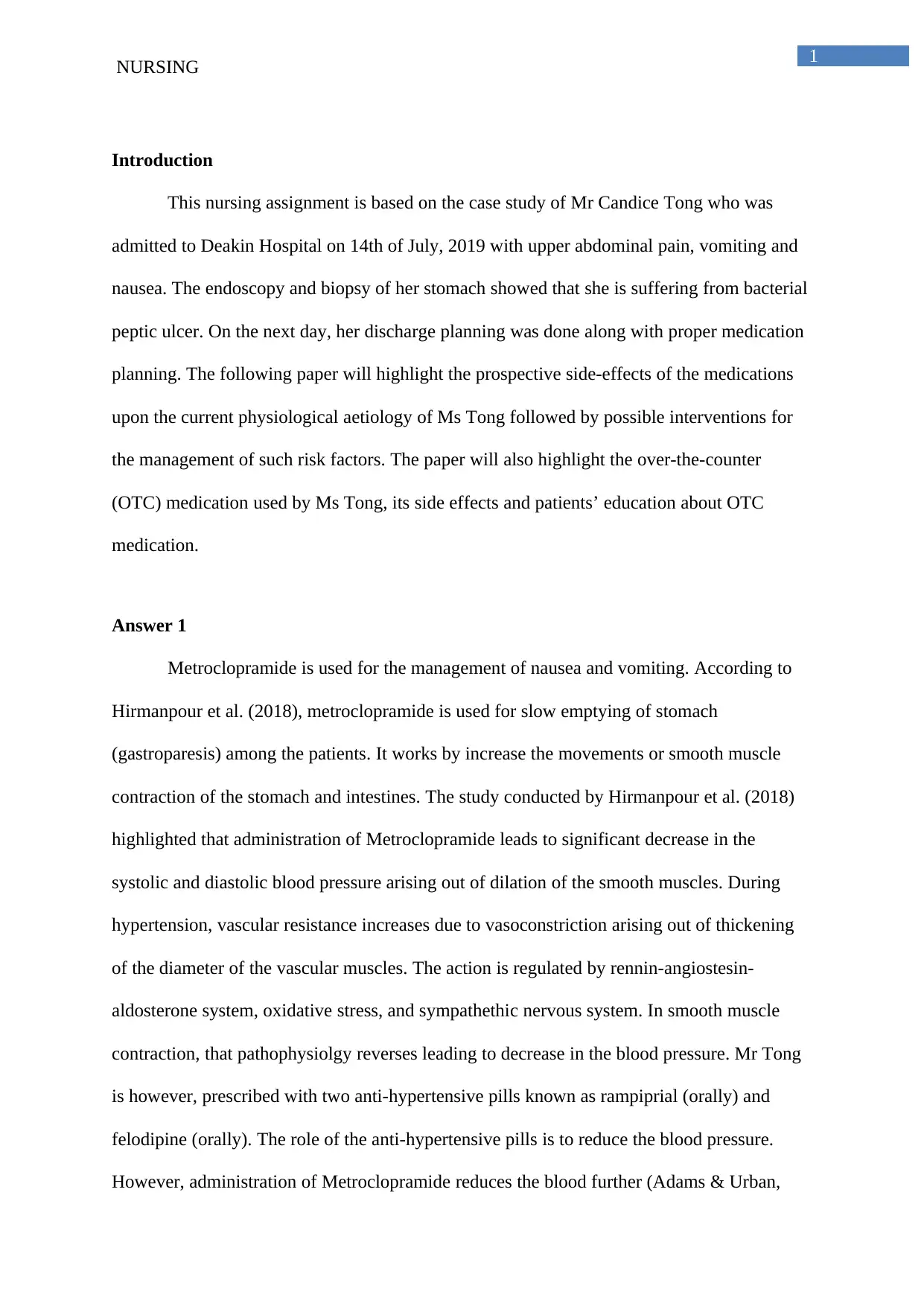
1
NURSING
Introduction
This nursing assignment is based on the case study of Mr Candice Tong who was
admitted to Deakin Hospital on 14th of July, 2019 with upper abdominal pain, vomiting and
nausea. The endoscopy and biopsy of her stomach showed that she is suffering from bacterial
peptic ulcer. On the next day, her discharge planning was done along with proper medication
planning. The following paper will highlight the prospective side-effects of the medications
upon the current physiological aetiology of Ms Tong followed by possible interventions for
the management of such risk factors. The paper will also highlight the over-the-counter
(OTC) medication used by Ms Tong, its side effects and patients’ education about OTC
medication.
Answer 1
Metroclopramide is used for the management of nausea and vomiting. According to
Hirmanpour et al. (2018), metroclopramide is used for slow emptying of stomach
(gastroparesis) among the patients. It works by increase the movements or smooth muscle
contraction of the stomach and intestines. The study conducted by Hirmanpour et al. (2018)
highlighted that administration of Metroclopramide leads to significant decrease in the
systolic and diastolic blood pressure arising out of dilation of the smooth muscles. During
hypertension, vascular resistance increases due to vasoconstriction arising out of thickening
of the diameter of the vascular muscles. The action is regulated by rennin-angiostesin-
aldosterone system, oxidative stress, and sympathethic nervous system. In smooth muscle
contraction, that pathophysiolgy reverses leading to decrease in the blood pressure. Mr Tong
is however, prescribed with two anti-hypertensive pills known as rampiprial (orally) and
felodipine (orally). The role of the anti-hypertensive pills is to reduce the blood pressure.
However, administration of Metroclopramide reduces the blood further (Adams & Urban,
NURSING
Introduction
This nursing assignment is based on the case study of Mr Candice Tong who was
admitted to Deakin Hospital on 14th of July, 2019 with upper abdominal pain, vomiting and
nausea. The endoscopy and biopsy of her stomach showed that she is suffering from bacterial
peptic ulcer. On the next day, her discharge planning was done along with proper medication
planning. The following paper will highlight the prospective side-effects of the medications
upon the current physiological aetiology of Ms Tong followed by possible interventions for
the management of such risk factors. The paper will also highlight the over-the-counter
(OTC) medication used by Ms Tong, its side effects and patients’ education about OTC
medication.
Answer 1
Metroclopramide is used for the management of nausea and vomiting. According to
Hirmanpour et al. (2018), metroclopramide is used for slow emptying of stomach
(gastroparesis) among the patients. It works by increase the movements or smooth muscle
contraction of the stomach and intestines. The study conducted by Hirmanpour et al. (2018)
highlighted that administration of Metroclopramide leads to significant decrease in the
systolic and diastolic blood pressure arising out of dilation of the smooth muscles. During
hypertension, vascular resistance increases due to vasoconstriction arising out of thickening
of the diameter of the vascular muscles. The action is regulated by rennin-angiostesin-
aldosterone system, oxidative stress, and sympathethic nervous system. In smooth muscle
contraction, that pathophysiolgy reverses leading to decrease in the blood pressure. Mr Tong
is however, prescribed with two anti-hypertensive pills known as rampiprial (orally) and
felodipine (orally). The role of the anti-hypertensive pills is to reduce the blood pressure.
However, administration of Metroclopramide reduces the blood further (Adams & Urban,
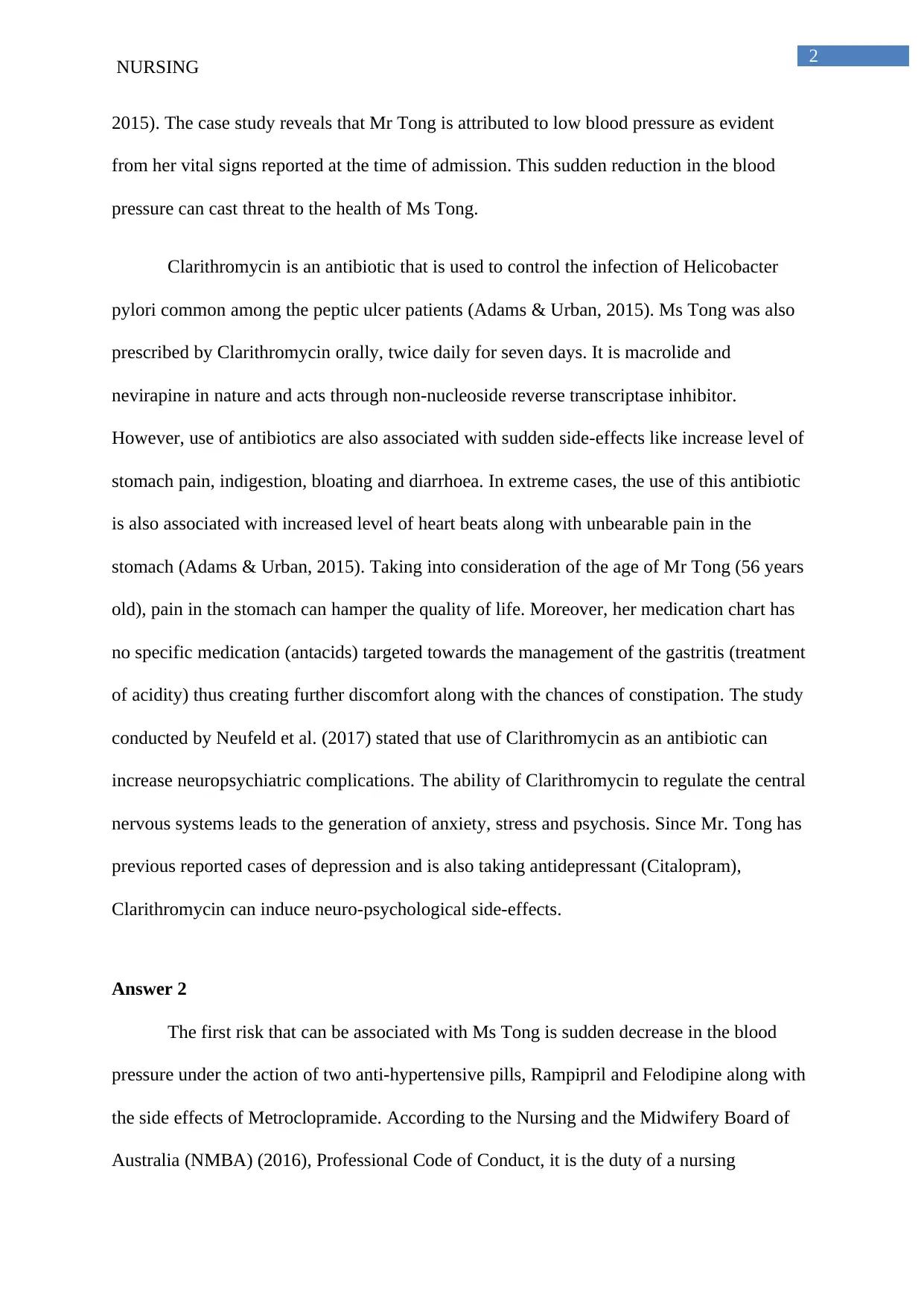
2
NURSING
2015). The case study reveals that Mr Tong is attributed to low blood pressure as evident
from her vital signs reported at the time of admission. This sudden reduction in the blood
pressure can cast threat to the health of Ms Tong.
Clarithromycin is an antibiotic that is used to control the infection of Helicobacter
pylori common among the peptic ulcer patients (Adams & Urban, 2015). Ms Tong was also
prescribed by Clarithromycin orally, twice daily for seven days. It is macrolide and
nevirapine in nature and acts through non-nucleoside reverse transcriptase inhibitor.
However, use of antibiotics are also associated with sudden side-effects like increase level of
stomach pain, indigestion, bloating and diarrhoea. In extreme cases, the use of this antibiotic
is also associated with increased level of heart beats along with unbearable pain in the
stomach (Adams & Urban, 2015). Taking into consideration of the age of Mr Tong (56 years
old), pain in the stomach can hamper the quality of life. Moreover, her medication chart has
no specific medication (antacids) targeted towards the management of the gastritis (treatment
of acidity) thus creating further discomfort along with the chances of constipation. The study
conducted by Neufeld et al. (2017) stated that use of Clarithromycin as an antibiotic can
increase neuropsychiatric complications. The ability of Clarithromycin to regulate the central
nervous systems leads to the generation of anxiety, stress and psychosis. Since Mr. Tong has
previous reported cases of depression and is also taking antidepressant (Citalopram),
Clarithromycin can induce neuro-psychological side-effects.
Answer 2
The first risk that can be associated with Ms Tong is sudden decrease in the blood
pressure under the action of two anti-hypertensive pills, Rampipril and Felodipine along with
the side effects of Metroclopramide. According to the Nursing and the Midwifery Board of
Australia (NMBA) (2016), Professional Code of Conduct, it is the duty of a nursing
NURSING
2015). The case study reveals that Mr Tong is attributed to low blood pressure as evident
from her vital signs reported at the time of admission. This sudden reduction in the blood
pressure can cast threat to the health of Ms Tong.
Clarithromycin is an antibiotic that is used to control the infection of Helicobacter
pylori common among the peptic ulcer patients (Adams & Urban, 2015). Ms Tong was also
prescribed by Clarithromycin orally, twice daily for seven days. It is macrolide and
nevirapine in nature and acts through non-nucleoside reverse transcriptase inhibitor.
However, use of antibiotics are also associated with sudden side-effects like increase level of
stomach pain, indigestion, bloating and diarrhoea. In extreme cases, the use of this antibiotic
is also associated with increased level of heart beats along with unbearable pain in the
stomach (Adams & Urban, 2015). Taking into consideration of the age of Mr Tong (56 years
old), pain in the stomach can hamper the quality of life. Moreover, her medication chart has
no specific medication (antacids) targeted towards the management of the gastritis (treatment
of acidity) thus creating further discomfort along with the chances of constipation. The study
conducted by Neufeld et al. (2017) stated that use of Clarithromycin as an antibiotic can
increase neuropsychiatric complications. The ability of Clarithromycin to regulate the central
nervous systems leads to the generation of anxiety, stress and psychosis. Since Mr. Tong has
previous reported cases of depression and is also taking antidepressant (Citalopram),
Clarithromycin can induce neuro-psychological side-effects.
Answer 2
The first risk that can be associated with Ms Tong is sudden decrease in the blood
pressure under the action of two anti-hypertensive pills, Rampipril and Felodipine along with
the side effects of Metroclopramide. According to the Nursing and the Midwifery Board of
Australia (NMBA) (2016), Professional Code of Conduct, it is the duty of a nursing
⊘ This is a preview!⊘
Do you want full access?
Subscribe today to unlock all pages.

Trusted by 1+ million students worldwide
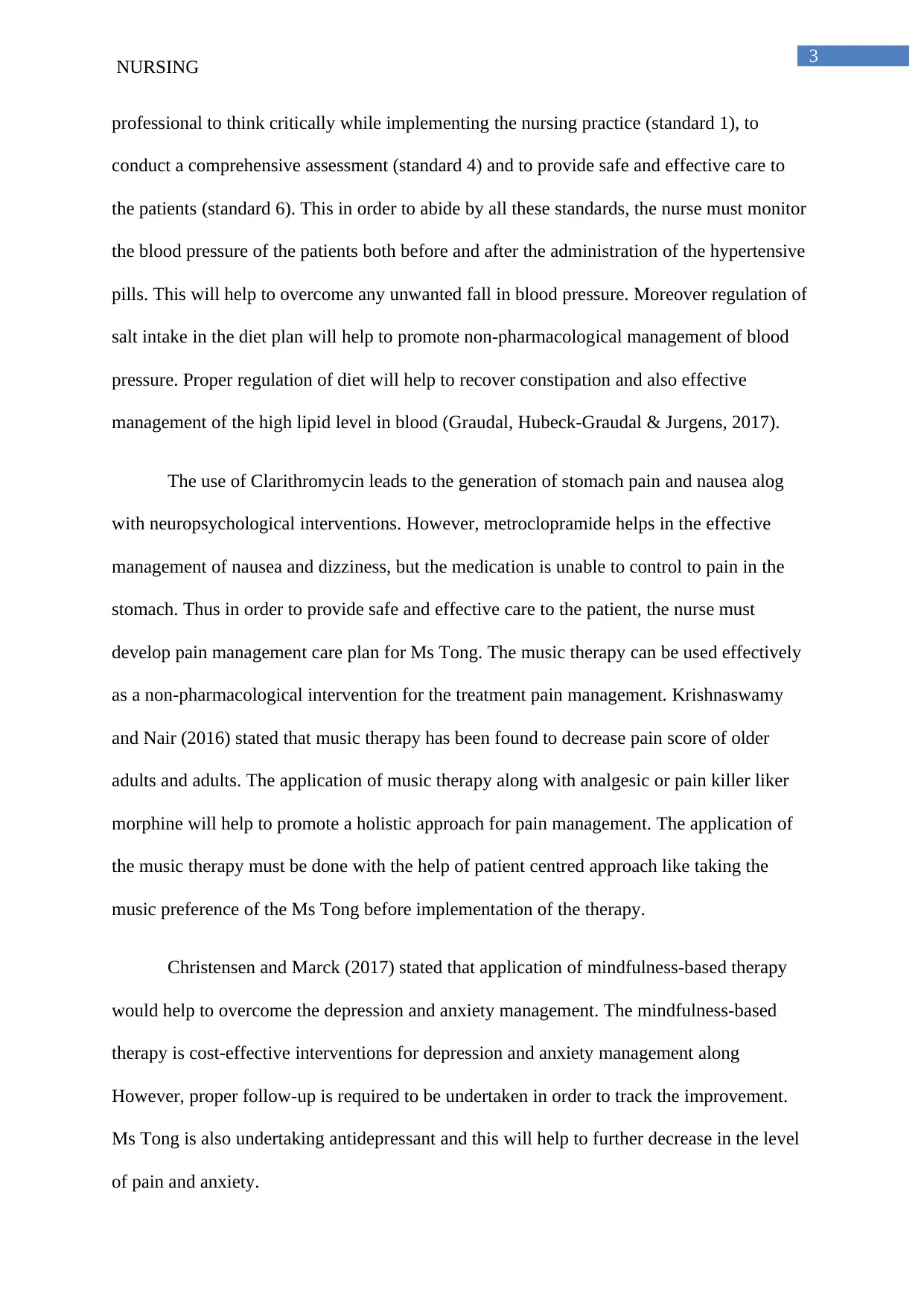
3
NURSING
professional to think critically while implementing the nursing practice (standard 1), to
conduct a comprehensive assessment (standard 4) and to provide safe and effective care to
the patients (standard 6). This in order to abide by all these standards, the nurse must monitor
the blood pressure of the patients both before and after the administration of the hypertensive
pills. This will help to overcome any unwanted fall in blood pressure. Moreover regulation of
salt intake in the diet plan will help to promote non-pharmacological management of blood
pressure. Proper regulation of diet will help to recover constipation and also effective
management of the high lipid level in blood (Graudal, Hubeck‐Graudal & Jurgens, 2017).
The use of Clarithromycin leads to the generation of stomach pain and nausea alog
with neuropsychological interventions. However, metroclopramide helps in the effective
management of nausea and dizziness, but the medication is unable to control to pain in the
stomach. Thus in order to provide safe and effective care to the patient, the nurse must
develop pain management care plan for Ms Tong. The music therapy can be used effectively
as a non-pharmacological intervention for the treatment pain management. Krishnaswamy
and Nair (2016) stated that music therapy has been found to decrease pain score of older
adults and adults. The application of music therapy along with analgesic or pain killer liker
morphine will help to promote a holistic approach for pain management. The application of
the music therapy must be done with the help of patient centred approach like taking the
music preference of the Ms Tong before implementation of the therapy.
Christensen and Marck (2017) stated that application of mindfulness-based therapy
would help to overcome the depression and anxiety management. The mindfulness-based
therapy is cost-effective interventions for depression and anxiety management along
However, proper follow-up is required to be undertaken in order to track the improvement.
Ms Tong is also undertaking antidepressant and this will help to further decrease in the level
of pain and anxiety.
NURSING
professional to think critically while implementing the nursing practice (standard 1), to
conduct a comprehensive assessment (standard 4) and to provide safe and effective care to
the patients (standard 6). This in order to abide by all these standards, the nurse must monitor
the blood pressure of the patients both before and after the administration of the hypertensive
pills. This will help to overcome any unwanted fall in blood pressure. Moreover regulation of
salt intake in the diet plan will help to promote non-pharmacological management of blood
pressure. Proper regulation of diet will help to recover constipation and also effective
management of the high lipid level in blood (Graudal, Hubeck‐Graudal & Jurgens, 2017).
The use of Clarithromycin leads to the generation of stomach pain and nausea alog
with neuropsychological interventions. However, metroclopramide helps in the effective
management of nausea and dizziness, but the medication is unable to control to pain in the
stomach. Thus in order to provide safe and effective care to the patient, the nurse must
develop pain management care plan for Ms Tong. The music therapy can be used effectively
as a non-pharmacological intervention for the treatment pain management. Krishnaswamy
and Nair (2016) stated that music therapy has been found to decrease pain score of older
adults and adults. The application of music therapy along with analgesic or pain killer liker
morphine will help to promote a holistic approach for pain management. The application of
the music therapy must be done with the help of patient centred approach like taking the
music preference of the Ms Tong before implementation of the therapy.
Christensen and Marck (2017) stated that application of mindfulness-based therapy
would help to overcome the depression and anxiety management. The mindfulness-based
therapy is cost-effective interventions for depression and anxiety management along
However, proper follow-up is required to be undertaken in order to track the improvement.
Ms Tong is also undertaking antidepressant and this will help to further decrease in the level
of pain and anxiety.
Paraphrase This Document
Need a fresh take? Get an instant paraphrase of this document with our AI Paraphraser
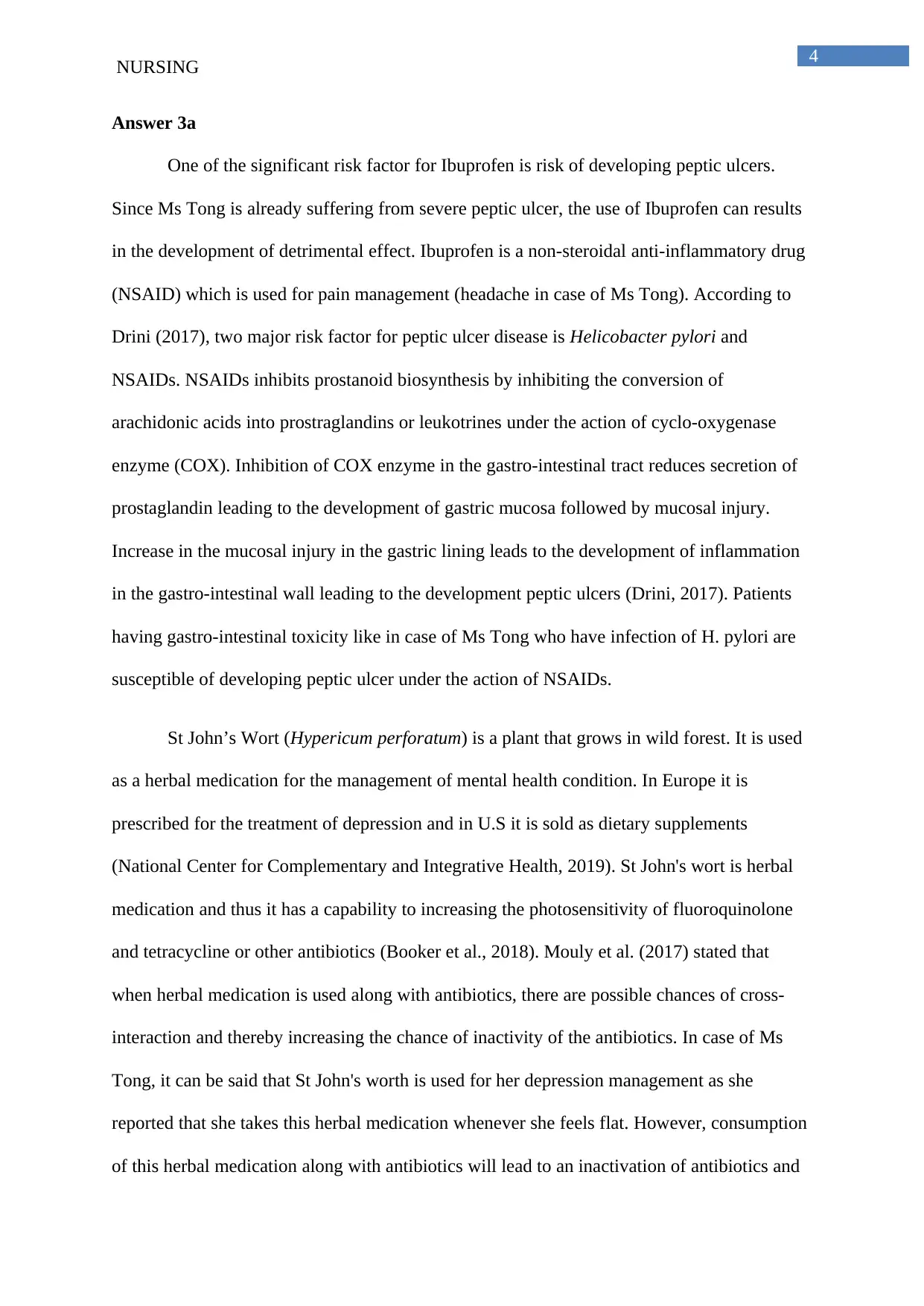
4
NURSING
Answer 3a
One of the significant risk factor for Ibuprofen is risk of developing peptic ulcers.
Since Ms Tong is already suffering from severe peptic ulcer, the use of Ibuprofen can results
in the development of detrimental effect. Ibuprofen is a non-steroidal anti-inflammatory drug
(NSAID) which is used for pain management (headache in case of Ms Tong). According to
Drini (2017), two major risk factor for peptic ulcer disease is Helicobacter pylori and
NSAIDs. NSAIDs inhibits prostanoid biosynthesis by inhibiting the conversion of
arachidonic acids into prostraglandins or leukotrines under the action of cyclo-oxygenase
enzyme (COX). Inhibition of COX enzyme in the gastro-intestinal tract reduces secretion of
prostaglandin leading to the development of gastric mucosa followed by mucosal injury.
Increase in the mucosal injury in the gastric lining leads to the development of inflammation
in the gastro-intestinal wall leading to the development peptic ulcers (Drini, 2017). Patients
having gastro-intestinal toxicity like in case of Ms Tong who have infection of H. pylori are
susceptible of developing peptic ulcer under the action of NSAIDs.
St John’s Wort (Hypericum perforatum) is a plant that grows in wild forest. It is used
as a herbal medication for the management of mental health condition. In Europe it is
prescribed for the treatment of depression and in U.S it is sold as dietary supplements
(National Center for Complementary and Integrative Health, 2019). St John's wort is herbal
medication and thus it has a capability to increasing the photosensitivity of fluoroquinolone
and tetracycline or other antibiotics (Booker et al., 2018). Mouly et al. (2017) stated that
when herbal medication is used along with antibiotics, there are possible chances of cross-
interaction and thereby increasing the chance of inactivity of the antibiotics. In case of Ms
Tong, it can be said that St John's worth is used for her depression management as she
reported that she takes this herbal medication whenever she feels flat. However, consumption
of this herbal medication along with antibiotics will lead to an inactivation of antibiotics and
NURSING
Answer 3a
One of the significant risk factor for Ibuprofen is risk of developing peptic ulcers.
Since Ms Tong is already suffering from severe peptic ulcer, the use of Ibuprofen can results
in the development of detrimental effect. Ibuprofen is a non-steroidal anti-inflammatory drug
(NSAID) which is used for pain management (headache in case of Ms Tong). According to
Drini (2017), two major risk factor for peptic ulcer disease is Helicobacter pylori and
NSAIDs. NSAIDs inhibits prostanoid biosynthesis by inhibiting the conversion of
arachidonic acids into prostraglandins or leukotrines under the action of cyclo-oxygenase
enzyme (COX). Inhibition of COX enzyme in the gastro-intestinal tract reduces secretion of
prostaglandin leading to the development of gastric mucosa followed by mucosal injury.
Increase in the mucosal injury in the gastric lining leads to the development of inflammation
in the gastro-intestinal wall leading to the development peptic ulcers (Drini, 2017). Patients
having gastro-intestinal toxicity like in case of Ms Tong who have infection of H. pylori are
susceptible of developing peptic ulcer under the action of NSAIDs.
St John’s Wort (Hypericum perforatum) is a plant that grows in wild forest. It is used
as a herbal medication for the management of mental health condition. In Europe it is
prescribed for the treatment of depression and in U.S it is sold as dietary supplements
(National Center for Complementary and Integrative Health, 2019). St John's wort is herbal
medication and thus it has a capability to increasing the photosensitivity of fluoroquinolone
and tetracycline or other antibiotics (Booker et al., 2018). Mouly et al. (2017) stated that
when herbal medication is used along with antibiotics, there are possible chances of cross-
interaction and thereby increasing the chance of inactivity of the antibiotics. In case of Ms
Tong, it can be said that St John's worth is used for her depression management as she
reported that she takes this herbal medication whenever she feels flat. However, consumption
of this herbal medication along with antibiotics will lead to an inactivation of antibiotics and
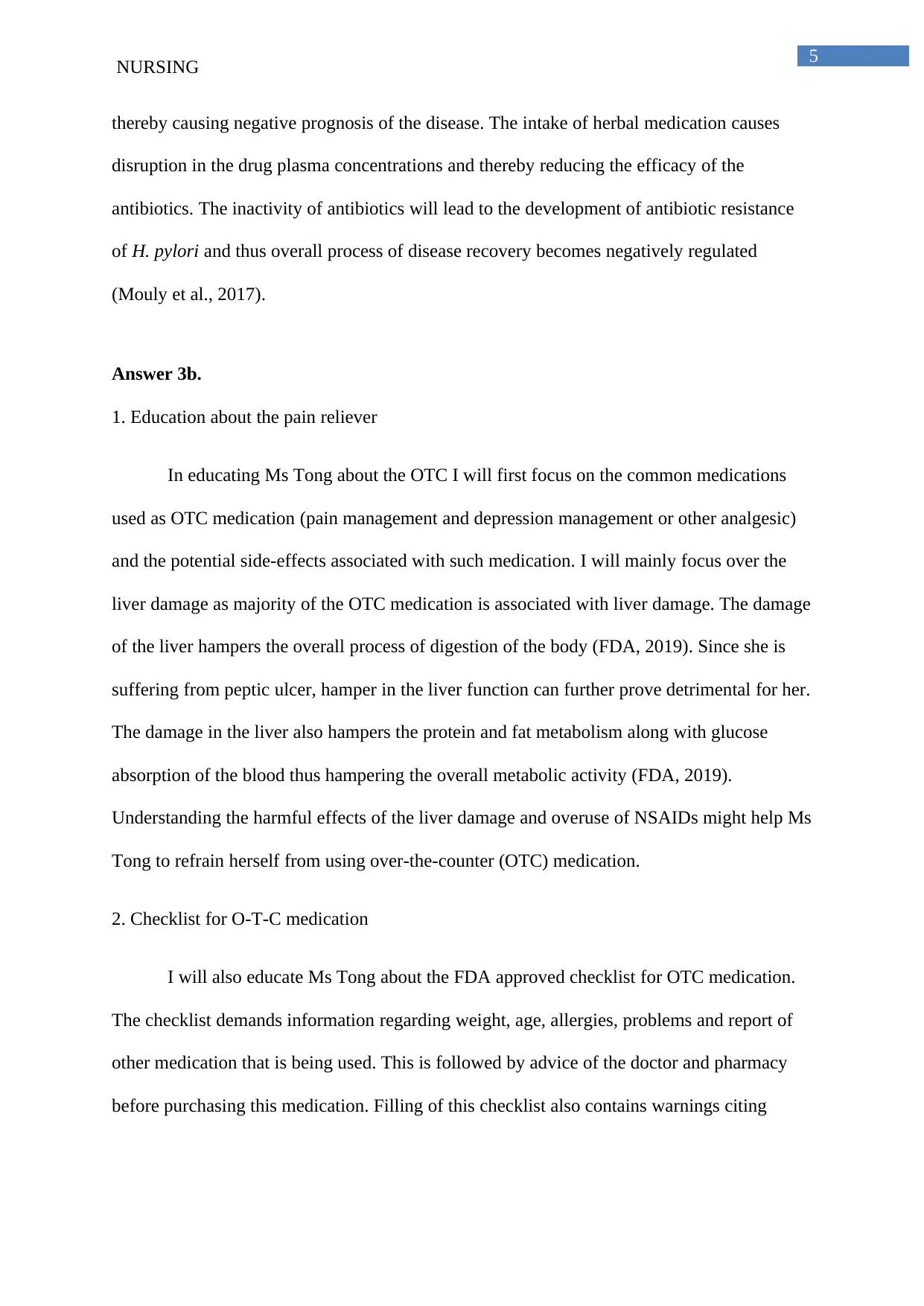
5
NURSING
thereby causing negative prognosis of the disease. The intake of herbal medication causes
disruption in the drug plasma concentrations and thereby reducing the efficacy of the
antibiotics. The inactivity of antibiotics will lead to the development of antibiotic resistance
of H. pylori and thus overall process of disease recovery becomes negatively regulated
(Mouly et al., 2017).
Answer 3b.
1. Education about the pain reliever
In educating Ms Tong about the OTC I will first focus on the common medications
used as OTC medication (pain management and depression management or other analgesic)
and the potential side-effects associated with such medication. I will mainly focus over the
liver damage as majority of the OTC medication is associated with liver damage. The damage
of the liver hampers the overall process of digestion of the body (FDA, 2019). Since she is
suffering from peptic ulcer, hamper in the liver function can further prove detrimental for her.
The damage in the liver also hampers the protein and fat metabolism along with glucose
absorption of the blood thus hampering the overall metabolic activity (FDA, 2019).
Understanding the harmful effects of the liver damage and overuse of NSAIDs might help Ms
Tong to refrain herself from using over-the-counter (OTC) medication.
2. Checklist for O-T-C medication
I will also educate Ms Tong about the FDA approved checklist for OTC medication.
The checklist demands information regarding weight, age, allergies, problems and report of
other medication that is being used. This is followed by advice of the doctor and pharmacy
before purchasing this medication. Filling of this checklist also contains warnings citing
NURSING
thereby causing negative prognosis of the disease. The intake of herbal medication causes
disruption in the drug plasma concentrations and thereby reducing the efficacy of the
antibiotics. The inactivity of antibiotics will lead to the development of antibiotic resistance
of H. pylori and thus overall process of disease recovery becomes negatively regulated
(Mouly et al., 2017).
Answer 3b.
1. Education about the pain reliever
In educating Ms Tong about the OTC I will first focus on the common medications
used as OTC medication (pain management and depression management or other analgesic)
and the potential side-effects associated with such medication. I will mainly focus over the
liver damage as majority of the OTC medication is associated with liver damage. The damage
of the liver hampers the overall process of digestion of the body (FDA, 2019). Since she is
suffering from peptic ulcer, hamper in the liver function can further prove detrimental for her.
The damage in the liver also hampers the protein and fat metabolism along with glucose
absorption of the blood thus hampering the overall metabolic activity (FDA, 2019).
Understanding the harmful effects of the liver damage and overuse of NSAIDs might help Ms
Tong to refrain herself from using over-the-counter (OTC) medication.
2. Checklist for O-T-C medication
I will also educate Ms Tong about the FDA approved checklist for OTC medication.
The checklist demands information regarding weight, age, allergies, problems and report of
other medication that is being used. This is followed by advice of the doctor and pharmacy
before purchasing this medication. Filling of this checklist also contains warnings citing
⊘ This is a preview!⊘
Do you want full access?
Subscribe today to unlock all pages.

Trusted by 1+ million students worldwide
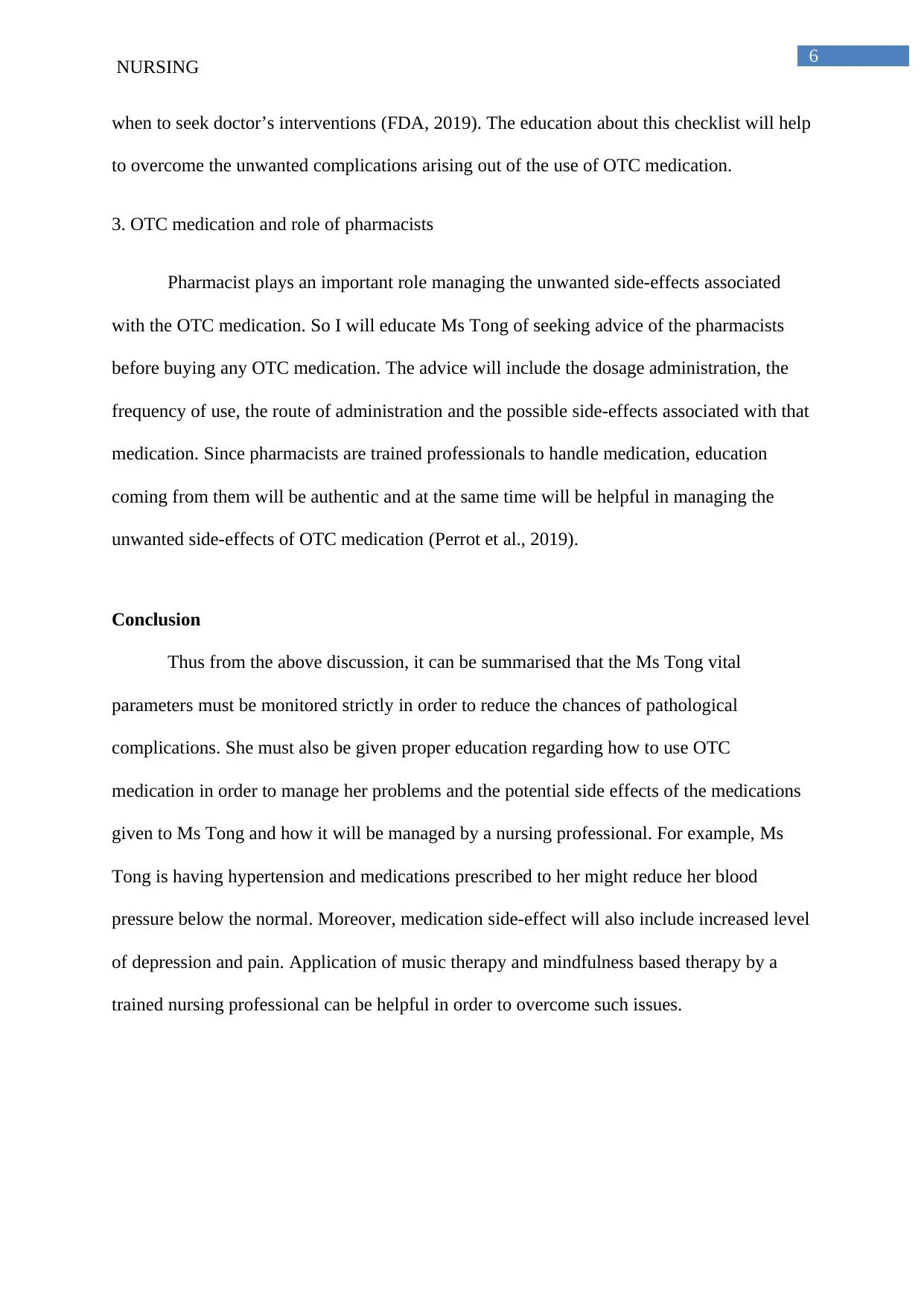
6
NURSING
when to seek doctor’s interventions (FDA, 2019). The education about this checklist will help
to overcome the unwanted complications arising out of the use of OTC medication.
3. OTC medication and role of pharmacists
Pharmacist plays an important role managing the unwanted side-effects associated
with the OTC medication. So I will educate Ms Tong of seeking advice of the pharmacists
before buying any OTC medication. The advice will include the dosage administration, the
frequency of use, the route of administration and the possible side-effects associated with that
medication. Since pharmacists are trained professionals to handle medication, education
coming from them will be authentic and at the same time will be helpful in managing the
unwanted side-effects of OTC medication (Perrot et al., 2019).
Conclusion
Thus from the above discussion, it can be summarised that the Ms Tong vital
parameters must be monitored strictly in order to reduce the chances of pathological
complications. She must also be given proper education regarding how to use OTC
medication in order to manage her problems and the potential side effects of the medications
given to Ms Tong and how it will be managed by a nursing professional. For example, Ms
Tong is having hypertension and medications prescribed to her might reduce her blood
pressure below the normal. Moreover, medication side-effect will also include increased level
of depression and pain. Application of music therapy and mindfulness based therapy by a
trained nursing professional can be helpful in order to overcome such issues.
NURSING
when to seek doctor’s interventions (FDA, 2019). The education about this checklist will help
to overcome the unwanted complications arising out of the use of OTC medication.
3. OTC medication and role of pharmacists
Pharmacist plays an important role managing the unwanted side-effects associated
with the OTC medication. So I will educate Ms Tong of seeking advice of the pharmacists
before buying any OTC medication. The advice will include the dosage administration, the
frequency of use, the route of administration and the possible side-effects associated with that
medication. Since pharmacists are trained professionals to handle medication, education
coming from them will be authentic and at the same time will be helpful in managing the
unwanted side-effects of OTC medication (Perrot et al., 2019).
Conclusion
Thus from the above discussion, it can be summarised that the Ms Tong vital
parameters must be monitored strictly in order to reduce the chances of pathological
complications. She must also be given proper education regarding how to use OTC
medication in order to manage her problems and the potential side effects of the medications
given to Ms Tong and how it will be managed by a nursing professional. For example, Ms
Tong is having hypertension and medications prescribed to her might reduce her blood
pressure below the normal. Moreover, medication side-effect will also include increased level
of depression and pain. Application of music therapy and mindfulness based therapy by a
trained nursing professional can be helpful in order to overcome such issues.
Paraphrase This Document
Need a fresh take? Get an instant paraphrase of this document with our AI Paraphraser
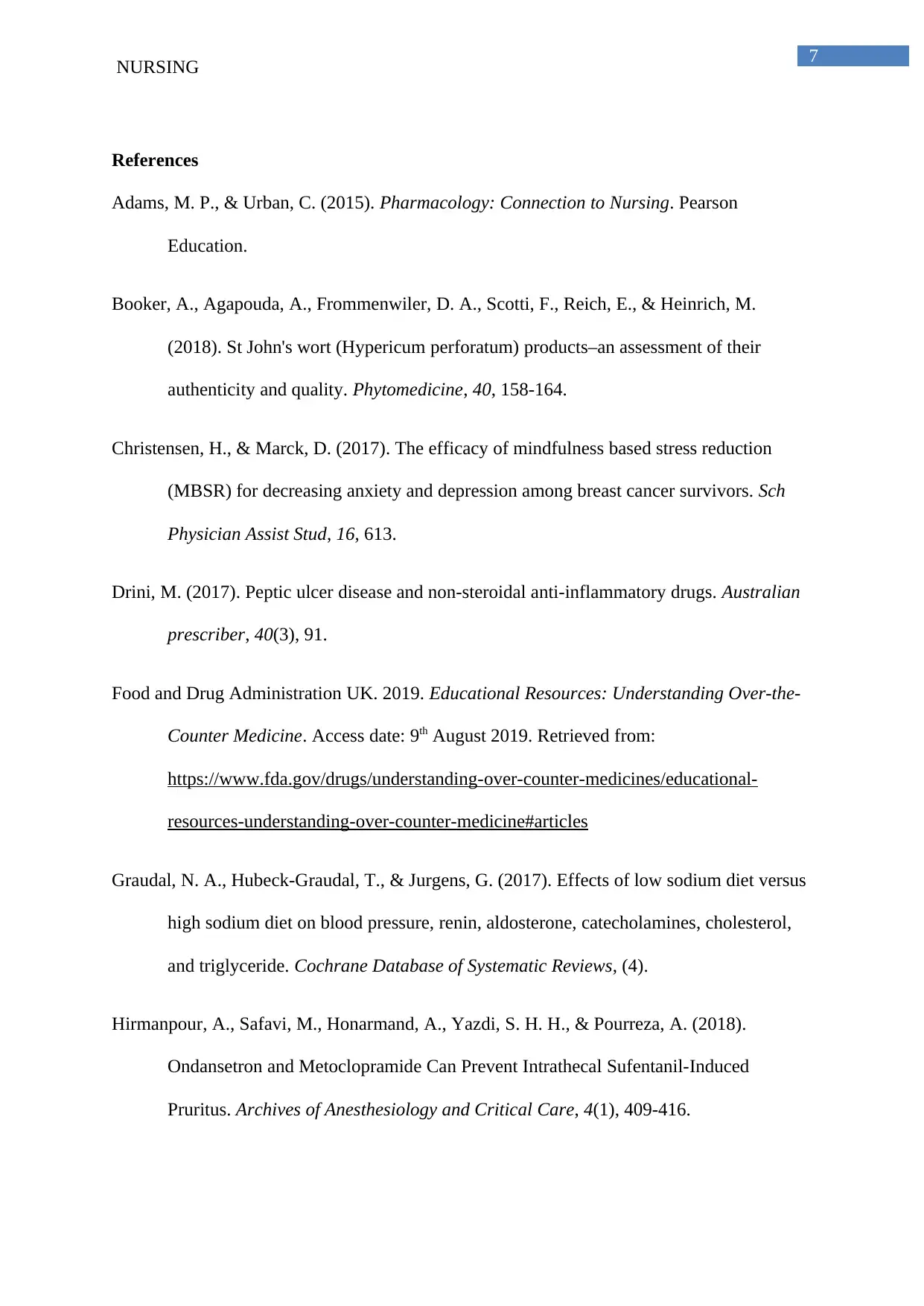
7
NURSING
References
Adams, M. P., & Urban, C. (2015). Pharmacology: Connection to Nursing. Pearson
Education.
Booker, A., Agapouda, A., Frommenwiler, D. A., Scotti, F., Reich, E., & Heinrich, M.
(2018). St John's wort (Hypericum perforatum) products–an assessment of their
authenticity and quality. Phytomedicine, 40, 158-164.
Christensen, H., & Marck, D. (2017). The efficacy of mindfulness based stress reduction
(MBSR) for decreasing anxiety and depression among breast cancer survivors. Sch
Physician Assist Stud, 16, 613.
Drini, M. (2017). Peptic ulcer disease and non-steroidal anti-inflammatory drugs. Australian
prescriber, 40(3), 91.
Food and Drug Administration UK. 2019. Educational Resources: Understanding Over-the-
Counter Medicine. Access date: 9th August 2019. Retrieved from:
https://www.fda.gov/drugs/understanding-over-counter-medicines/educational-
resources-understanding-over-counter-medicine#articles
Graudal, N. A., Hubeck‐Graudal, T., & Jurgens, G. (2017). Effects of low sodium diet versus
high sodium diet on blood pressure, renin, aldosterone, catecholamines, cholesterol,
and triglyceride. Cochrane Database of Systematic Reviews, (4).
Hirmanpour, A., Safavi, M., Honarmand, A., Yazdi, S. H. H., & Pourreza, A. (2018).
Ondansetron and Metoclopramide Can Prevent Intrathecal Sufentanil-Induced
Pruritus. Archives of Anesthesiology and Critical Care, 4(1), 409-416.
NURSING
References
Adams, M. P., & Urban, C. (2015). Pharmacology: Connection to Nursing. Pearson
Education.
Booker, A., Agapouda, A., Frommenwiler, D. A., Scotti, F., Reich, E., & Heinrich, M.
(2018). St John's wort (Hypericum perforatum) products–an assessment of their
authenticity and quality. Phytomedicine, 40, 158-164.
Christensen, H., & Marck, D. (2017). The efficacy of mindfulness based stress reduction
(MBSR) for decreasing anxiety and depression among breast cancer survivors. Sch
Physician Assist Stud, 16, 613.
Drini, M. (2017). Peptic ulcer disease and non-steroidal anti-inflammatory drugs. Australian
prescriber, 40(3), 91.
Food and Drug Administration UK. 2019. Educational Resources: Understanding Over-the-
Counter Medicine. Access date: 9th August 2019. Retrieved from:
https://www.fda.gov/drugs/understanding-over-counter-medicines/educational-
resources-understanding-over-counter-medicine#articles
Graudal, N. A., Hubeck‐Graudal, T., & Jurgens, G. (2017). Effects of low sodium diet versus
high sodium diet on blood pressure, renin, aldosterone, catecholamines, cholesterol,
and triglyceride. Cochrane Database of Systematic Reviews, (4).
Hirmanpour, A., Safavi, M., Honarmand, A., Yazdi, S. H. H., & Pourreza, A. (2018).
Ondansetron and Metoclopramide Can Prevent Intrathecal Sufentanil-Induced
Pruritus. Archives of Anesthesiology and Critical Care, 4(1), 409-416.
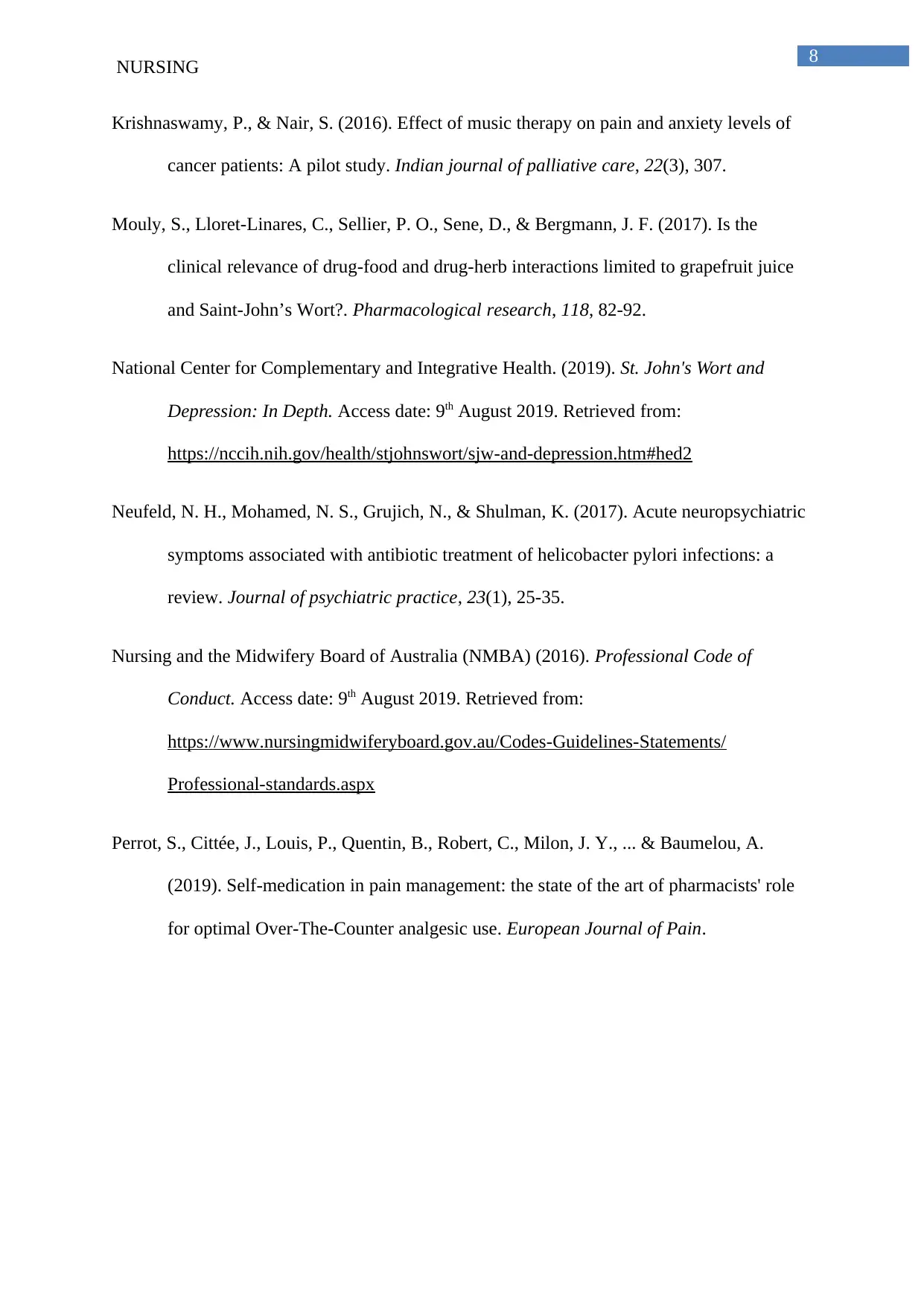
8
NURSING
Krishnaswamy, P., & Nair, S. (2016). Effect of music therapy on pain and anxiety levels of
cancer patients: A pilot study. Indian journal of palliative care, 22(3), 307.
Mouly, S., Lloret-Linares, C., Sellier, P. O., Sene, D., & Bergmann, J. F. (2017). Is the
clinical relevance of drug-food and drug-herb interactions limited to grapefruit juice
and Saint-John’s Wort?. Pharmacological research, 118, 82-92.
National Center for Complementary and Integrative Health. (2019). St. John's Wort and
Depression: In Depth. Access date: 9th August 2019. Retrieved from:
https://nccih.nih.gov/health/stjohnswort/sjw-and-depression.htm#hed2
Neufeld, N. H., Mohamed, N. S., Grujich, N., & Shulman, K. (2017). Acute neuropsychiatric
symptoms associated with antibiotic treatment of helicobacter pylori infections: a
review. Journal of psychiatric practice, 23(1), 25-35.
Nursing and the Midwifery Board of Australia (NMBA) (2016). Professional Code of
Conduct. Access date: 9th August 2019. Retrieved from:
https://www.nursingmidwiferyboard.gov.au/Codes-Guidelines-Statements/
Professional-standards.aspx
Perrot, S., Cittée, J., Louis, P., Quentin, B., Robert, C., Milon, J. Y., ... & Baumelou, A.
(2019). Self‐medication in pain management: the state of the art of pharmacists' role
for optimal Over‐The‐Counter analgesic use. European Journal of Pain.
NURSING
Krishnaswamy, P., & Nair, S. (2016). Effect of music therapy on pain and anxiety levels of
cancer patients: A pilot study. Indian journal of palliative care, 22(3), 307.
Mouly, S., Lloret-Linares, C., Sellier, P. O., Sene, D., & Bergmann, J. F. (2017). Is the
clinical relevance of drug-food and drug-herb interactions limited to grapefruit juice
and Saint-John’s Wort?. Pharmacological research, 118, 82-92.
National Center for Complementary and Integrative Health. (2019). St. John's Wort and
Depression: In Depth. Access date: 9th August 2019. Retrieved from:
https://nccih.nih.gov/health/stjohnswort/sjw-and-depression.htm#hed2
Neufeld, N. H., Mohamed, N. S., Grujich, N., & Shulman, K. (2017). Acute neuropsychiatric
symptoms associated with antibiotic treatment of helicobacter pylori infections: a
review. Journal of psychiatric practice, 23(1), 25-35.
Nursing and the Midwifery Board of Australia (NMBA) (2016). Professional Code of
Conduct. Access date: 9th August 2019. Retrieved from:
https://www.nursingmidwiferyboard.gov.au/Codes-Guidelines-Statements/
Professional-standards.aspx
Perrot, S., Cittée, J., Louis, P., Quentin, B., Robert, C., Milon, J. Y., ... & Baumelou, A.
(2019). Self‐medication in pain management: the state of the art of pharmacists' role
for optimal Over‐The‐Counter analgesic use. European Journal of Pain.
⊘ This is a preview!⊘
Do you want full access?
Subscribe today to unlock all pages.

Trusted by 1+ million students worldwide
1 out of 9
Related Documents
Your All-in-One AI-Powered Toolkit for Academic Success.
+13062052269
info@desklib.com
Available 24*7 on WhatsApp / Email
![[object Object]](/_next/static/media/star-bottom.7253800d.svg)
Unlock your academic potential
Copyright © 2020–2025 A2Z Services. All Rights Reserved. Developed and managed by ZUCOL.





